Ad
Interviewing Users: Spinning Data Into Gold
- 2. Brought to you by
- 3. Introduction
- 4. TodayIntroduction 9:00 – 9:10Best Practices Overview 9:10 – 10:00Methods10:00 – 10:30Break10:30 – 10:45Interviewing 10:45 – 11:30Interviewing Exercise11:30 – 12:15Lunch!Observation Exercise 1:15 – 2:00Synthesis 2:00 – 2:45Break2:45 – 3:00Ideation3:00 – 4:00Share4:00 – 4:30Q&A + Wrap-up 4:30 – 5:00
- 5. Take a fresh look at peopleUse existing ideas as hypothesesWhat to make or doRefine & prototypeLaunchIterate & improveUse fieldwork throughout the development cycleExplore new ideas
- 6. Synthesis & ideation processFieldworkSynthesisIdeationDevelopment
- 7. Cultural data from fieldworkCase study: iPod accessories
- 8. Case study: iPod accessoriesPortigalInterviewing Users: Spinning Data into Gold8
- 9. Research Project – Best Practices Overview
- 10. What do I mean by “research?”EthnographyEthnographic interviews Video ethnographyDepth-interviewsContextual researchHome visitsSite visitsExperience modelingDesign researchUser researchUser-centered designOne-on-onesCamera studies User safaris
- 11. What do I mean by “research?”EthnographyEthnographic interviews Video ethnographyDepth-interviewsContextual researchHome visitsSite visitsExperience modelingDesign researchUser researchUser-centered designOne-on-onesCamera studies User safaris What-ever!
- 12. Beyond our terminology, what are we doing?Examine people in their own contextWhat are they doing?
- 13. What does it mean?Infer (interpret/synthesize/etc.)Find the connections
- 14. The researcher is the “apparatus”Apply to business or design problemsUse products, services, packaging, design to tell the right story
- 15. More possible types of solutions than we started out withIdentifying the problem
- 16. The Business QuestionWhat new products and services can you offer to help partners increase social network stickiness (and thus revenues)?What entertainment activities should you support to tap into a growing middle-class in China?
- 17. The Research QuestionWhat are the motivations, successes, and frustrations for current and prospective users of our partners’ social media sites?How is family life changing in middle-class China? What are the critical digital and analog technologies that are being embraced?
- 18. Pain points: default research/business question?!While we always uncover so-called pain points, the bigger opportunity may come from understanding why– how did we get here?
- 19. It may not really be that painfulSatisficing(coined by Herbert Simon in 1956) refers to our acceptance of good-enough solutionsThese can drive engineers and designers crazy…but the real problem isn’t always what it appears to be
- 21. Finding the right participants (aka recruiting)Often an afterthought in project planningBut the right customers are crucial to get the right insights
- 22. This takes time to plan and to executePointless interviews waste time and challenge the credibility of the workPerson doesn’t really want to talk to you
- 23. They don’t have the desired relationship with the product/brandEpic FAILS will happen anywayIdentifyWhat type of people you want to find (criteria, screener)
- 24. How you will find those peopleRecruiting criteria: Relationship to categoryWhat is their relationship to the product/service/brand/activity? Typical user
- 25. Non-user
- 26. Extreme user
- 27. Peripheral user
- 28. Expert user
- 30. Wannabe user
- 31. Should-be user
- 32. Future user
- 33. Past user
- 34. Hater
- 35. Loyal to competitorTriangulate through multiple perspectivesBy creating contrast, you reveal key influencing factorsthat you wouldn’t otherwise see
- 36. Recruiting criteria: Type of userThere may be more – or different – “users”Think about the whole system: the chooser, the influencer, the user, and anyone who is impacted by those rolesChallenge assumptions about who the organization is implicitly/explicitly designing forIs that everyone?
- 37. Do they even exist?Surface a broader sense – even prior to research – about who is affected by the product and who is being designed forIs your “typical customer” real or aspirational?
- 38. Recruiting criteria: DemographicsGenderAgeLife stage/lifestyleMarried
- 39. Stage of family
- 40. Retirement
- 41. Not in the middle of a major life-change (unless that’s of interest)DwellingSuburban/urban/rural
- 42. Apartment/living alone/ roommates/single family homeRaceReflect the population
- 43. Reflect the user baseOccupationFrom outside the industries in questionIncomeCan afford the product in questionDemographic factors are typically secondarywhen defining the sample
- 44. The screenerScreeners are very formal, linear documentsTypically used by market research recruiting agenciesScreeners havetwo purposes…Does the person fits your criteria?
- 45. Convince them to participate…and three main sectionsIntroduction
- 47. Invitation to participateRecruiting criteria: The softer sideWhatever their relationship with the product/brand/service, you want the person to be engaged, have a point of view, care about the thing, and be articulate
- 48. Creative recruitingOutside of the traditional method of working with a recruiting agency, there are other approachesFriends and family/Social networks
- 49. Snowball recruiting (participants find more participants)
- 50. Craigslist
- 51. Intercepts
- 52. Etc.Pros and consCheap but time-consuming
- 53. Quick but harder to control and manage
- 54. Likely to find “pure” participants but they might be too close to youIncentiveEnthusiastic thank-you rather than compensationRecruiter will advise on best amount, depending on what you are asking for
- 55. For a fee, they will handle sending a check, but I prefer the immediate gratification of an envelope of cash
- 56. Include a thank-you note and even swagIn B2B settings, be creative about who and how to incentYou may negotiate this on a per-site basisThe interview guide (or field guide)A detailed plan of what will happen in the interviewQuestions, timing, activities, tasks, logistics, etc.Transforms questions-we-want-answers-to into questions-we-will-askShare with team to align on issues of concernEspecially with multiple teams in the fieldHelps you previsualizethe flow of the sessionInclude questions as well as other methods that you’ll usePrepping an interview guide means that you may not need to use the interview guideThis is counter-intuitive
- 57. It does come in handy during freeze-up moments – scan it over to see what else you want to coverFour sections to the field guideIntroduction and Participant BackgroundLogistics, timing, objectivesThe Main BodySubsections for each area you plan to explore (e.g., configuration, learning about new features, etc.)Projection/Dream QuestionsBe audacious and ask about predictions for the future or ideal experiencesWrap UpLogistics, ask about anything they want to tell you that you didn’t ask about
- 61. Documentation: photosPlan to take lots of photosThey will reveal things you don’t remember noticingEssential for storytellingMake sure you have permission before you start snapping
- 62. Documentation: audio, video, notesEssential to capture exactly what is saidDifficult (impossible) to maintain eye contact, manage interview, and write down everythingPotentially a role for a second interviewerTaking notes – not as the definitive record – can help you process, notice, think about follow-ups, etc.I strongly recommend privileging being in-the-moment (e.g., eye contact, listening) over trying to capture everything yourselfA release is a good ideaIt clarifies the rights of the interviewee and your organization Consent – participation is voluntary
- 63. Incentive – what the participant gets but they are not an employee
- 64. Model release – how images and video will be used
- 65. Non-disclosure – in case you disclose anything in-progressThese are legal documentsWill your legal department help you prepare it?
- 66. Can you influence them to create consumer-friendly, light-weight versions
- 67. Give participants their own copy at the outset of the interviewMethods
- 68. Ask people how they would solve a problemParticipatory designDoesn’t mean we implement the requested solution literally“I wish it had a handle”Many ways to solve the underlying need (“I need to move it around”)Designers work with this data to generate alternativesEngage people in the non-literal through games and role-playingUncover underlying principles and explore areas of opportunity that don’t yet exist
- 69. Show people a solutionConsider the difference betweentestingandexploringAvoid “Do you like this?”Don’t show your best guess at a solution; instead identify provocative examples to surface hidden desires and expectationsMake sure you are asking the right questionsWhat does this solution enable? What problems does it solve?Especially for new products, needed before getting into specifics of your implementationImage from Roberto and Worth1000.com
- 70. Use a range of methods
- 72. Workbook: Question and answer
- 76. Mapping
- 77. Storyboards
- 78. Mockups
- 79. Prototypes
- 80. Casual Card Sort
- 81. Methods can be a playgroundWe choose, mash-up, or create methods based on the problem, project constraints, and a desire to experimentBuild up a library of approaches and artifactsPortigalInterviewing Users: Spinning Data into Gold49
- 82. Break!
- 83. Interviewing
- 84. Principles inform tacticsI don't skate to where the puck is, I skate to where the puck is going to be – Wayne Gretzky
- 85. Fieldwork principlesCheck your worldview at the doorEmbrace how other people see the worldBuild rapportListen
- 86. Check your worldview at the doorBefore you start doing interviews, do a team-wide brain dump of all your assumptions and expectationsGet closely-held beliefs out of your heads
- 87. You needn’t go back to verify your assumptions; goal is to make assumptions explicitMake the interview about the interviewAs a transitional ritual, agree explicitly that you are going to Learn about Paul rather than Identify NextGen Opportunities for RoadmapEmbrace how other people see the worldGo to where your users are rather than asking them to come to youNip distractions in the budEat!
- 88. Leave plenty of time so you aren’t rushed when you arrive
- 89. Find a bathroom beforehandBe ready to ask questions you (think you) know the answers toThink about: “When are your taxes due?”
- 90. What do you know? What are you afraid they’ll say? What might you learn?Build rapportBe selective about social gracesJust enough small talk
- 91. Accept what you’re offeredBe selective about talking about yourselfReveal personal information to give them permission to share
- 92. Otherwise, think “OMG! Me too!” without saying itWork towards the tipping pointFrom question-answer to question-story
- 93. You won’t know when it’s coming; be patientAcknowledge the interview as something…unusual“What I want to learn today…” over friendly chatListenYou can demonstrate that you are listening by asking questions!Follow-up, follow-up, follow-up
- 94. “Earlier, you told us that…”
- 95. “I want to go back to something else you said…”Signal your transitions: “Great, now I’d like to move onto a totally different topic”This level of listening is not how we normally talk to each otherRemember that you are interviewing, not having a conversation
- 96. This is really hardListening body languageYes!Not so much.
- 97. Silence defeats awkwardnessAfter you ask your question, be silentDon’t put the answers in the questionAfter they’ve answered you, be silent
- 98. Use natural languageTalk like your subject talks!
- 99. Don’t make questions pass/fail (1/2)Client: So the concept of transferring, burning, and syncing, can you talk a little about those three concepts? So transfer, burn, and sync. Just do you understand the difference?Interviewee: Transfer, burn, sync. Burn is when I’m actually putting it onto some kind of disc.Okay…Transferring is I guess when I transfer the files from one place to the other.Mm-hmm…Whether it’s to a device or to a different drive or whatever or into the program I guess. And syncing, well, I know the phone always comes up and says it’s syncing, when it’s syncing up to the files or syncing up to the computer or stuff like that. That’s the only time I think I’ve ever really heard that.(cont’d)
- 100. Don’t make questions pass/fail (2/2)Client: So the only other question I have left in this area is: Would you expect to manually decide what music goes on your devices or would you rather that the machine does it for you?Interviewee: Decide what I want on my…?Let’s say your library is here on this machine, and you have a device, would you want it to put as much as it could put on from the library from the device when it’s connected to your computer?If I could hold it… if the device itself could actually hold all the files, I would love that, if it automatically…Just knew.Just knew that it wasn’t on there, the same thing when…what do you call it - when I have to go into the program and actually have it… downl…uhh, now I’m confused in what I should call it.No, no, don’t worry about it!
- 101. Don’t presume they accept your world viewClient: So, really interesting the sort of things that you as old Derek used to value, such as efficiency of time, and some of those things have now influenced the new Derek.Derek: Right.Steve: Maybe that sort of begs a larger question…We’ve offered you this idea of old versus new you, but how do you think about this transition?Derek:Yeah, I don’t really see it.
- 102. If you want to fix something, wait until the endFrustrating to watch users struggle with your productRemember, you are there to learn from themYou will lose the interview if you start taking their questionsWhen it’s time to go, show or tell them only what will help them
- 103. Find your personal styleThe Myers-Briggs Type Indicator
- 104. Questions to gather context and collect details
- 105. Questions to probe on what’s unsaid
- 106. Questions to probe on what’s unsaid
- 107. Questions to uncover mental models
- 108. Why so many types of questions?Real interviews aren’t as simple as asking a question, getting an answer, and then moving onto the next question in your list. You are unlikely to get to the actual answer without asking a few different questions a few different ways. You need a range of tools and techniques. And you need to feel when you haven’t got to the real answer yet so you can keep going.
- 109. Prepare for exploding questionsWell, my cousin never tells me when she has an updated bank balance so I figured I would handle it myself. That’s why I signed up for the PayPal service, I think it’s them but maybe not.Coping techniquesWait until these issues come up organically, without you having to askMake notes on your field guide about what you want to loop back to so you don’t forgetTriage based on what’s most pressing for your topicTriage based on what makes the best follow-up, to demonstrate listeningWhy does this matter?Let’s find out what service this is?!Okay.I decided I had to spend the money I had from last month in order to save month’s money and this service was going to help me do that. Even if it’s not the same password that my cousin would be usingI don’t understand her financial model…Why does she expect that it would be the same?
- 110. Exploding questions can lead to a flow state
- 111. Managing others in the fieldWe lead a thirty-minute training session for everyone who will join us in the fieldField teams are ideally 2, at most 3Ensure one person leads the interview and clarify the role of the “second interviewer”They should ask questions, but stay in the “chapter” that we’re inDuring our debriefs, we offer feedback and coaching about the process, if possible
- 112. Getting better at interviewingPractice with hallway or other serendipitous micro-interviewsWrite surveys and participant screeners to practice crafting questions out of the moment How do you get to Carnegie Hall?Practice, man, practice!
- 113. Participant screeners as asking practiceA good way to practice both framing a question and the empathic exercise of thinking through the respondent’s user experience with that question
- 114. Write and take surveysDevelop your own critical eye (and interviewer’s voice) by looking for bad examples and identifying just what’s wrong with them
- 115. We learn from mistakes and mishapsCollect and share war stories with other interviewersTHANX 4 NOTHING KITTEH
- 116. Interviewing ExerciseGet in groups of 3You are in a startup looking for opportunities in…Music – purpose/role/interests, technology, devices Food, groceries, meals, nutritionNews – media, information, sources, purposeReview sample interview guidesImagine the flow
- 117. Background, depth, reflectionThree rounds of interviews, 10-12 minutes each One interviewer, one interviewee, one observer
- 118. Each person plays each role once
- 119. Stay in the exercise!Group debrief
- 120. Giveaway #1Everyone gets a license for TechSmith’s screen capture tool SnagitExpect it by email in a couple of weeksEveryone gets 3 tests from UserTesting.comUse code uxworkshop; expires in 2 weeksDraw2 licenses for TechSmith’sCamtasia (Mac/PC)1 license for Techsmith’sMorae (PC)
- 121. Lunch
- 122. (The rest of) todayIntroduction 9:00 – 9:10Best Practices Overview 9:10 – 10:00Methods10:00 – 10:30Break10:30 – 10:45Interviewing 10:45 – 11:30Interviewing Exercise11:30 – 12:15Lunch!Observation Exercise 1:15 – 2:00Synthesis 2:00 – 2:45Break2:45 – 3:00Ideation3:00 – 4:00Share4:00 – 4:30Q&A + Wrap-up 4:30 – 5:00
- 124. Homework Check-inYour mission: Dedicate at least half an hour to walking around and observing people in your neighborhoodProps to Dylan, Caroline, and David!
- 125. Homework Check-inWho was able to do the assignment?Was this anyone’s first experience doing observational fieldwork?Is there anyone who has not done user or observational research in the field?
- 126. ObservingNotice what… people, placesNotice how… processes, sequences, interactionsSuspend your point of viewAvoid conclusionsAllow confusionDo it “out loud”Steve, practicing his “noticing.” You can tell because he looks like he may be a little confused.
- 127. You’re observing people within their culture. Notice how cultural artifacts reflect and define the environment; and reveal what is “normal”Normal isn’t “right or wrong” – it’s the set of background rules that define much of what people choose or ignoreMediaProductsAdvertisementsStreet CultureTrends/FadsCultural contextWhat are they selling?
- 128. Cultural context
- 129. Cultural context
- 130. Cultural context
- 131. Your mission: Imagine you are working on a project for Gentrific8, looking for ideas to redevelop parts Seattle around downtown and the Central Library.Form groups of 2 – 3. Mix it upWander and observe people, interactions and environmentsDo it out loud!Capture (photos, notes)What, who, where, when?Why, how?This is not a design audit of signage or merchandise displaysExercise: Explore!
- 132. Neighborhood observations: Noe Valley, San Fran
- 133. Neighborhood observations: Noe Valley, San Fran
- 134. Neighborhood observations: Montara, California
- 135. Be back by 2:25!Exercise: Explore!
- 136. Synthesis: From data to insights
- 137. AnalysisSynthesisIdeationSolutionsStrategiesOpportunitiesDetailed solutionsInsightsSynthesis & ideation process
- 139. Avoid jumping to conclusions
- 140. DTDT: Analysis vs. SynthesisAnalysisBreak large piece(s) into smaller ones in order to make sensee.g., interviews, transcripts into anecdotes, stories
- 141. DTDT: Analysis vs. SynthesisCombining multiple pieces into something new e.g., developing themes, implications, opportunitiesSynthesisAnalysisBreak large piece(s) into smaller ones in order to make sensee.g., interviews, transcripts into anecdotes, stories
- 142. DTDT: Analysis vs. SynthesisThe process gradually moves from one to the otherCombining multiple pieces into something new e.g., developing themes, implications, opportunitiesSynthesisAnalysisBreak large piece(s) into smaller ones in order to make sensee.g., interviews, transcripts into anecdotes, stories
- 143. Analthesis????Combining multiple pieces into something new e.g., developing themes, implications, opportunitiesSynthesisAnalysisBreak large piece(s) into smaller ones in order to make sensee.g., interviews, transcripts into anecdotes, stories
- 144. Sense-makingthrough an iterativeprocess of refining gathered dataEarly, Informaldata in your headFirst, process the experience you had collecting dataRefer to debriefs and conversationsArticulate and identify themesOutcome: Topline ReportProcess-based, Formalheavy liftingThen, process the data itselfIndividual and group analysisPattern-identification, clustering, models, frameworksOutcome: OpportunitiesMore narratively, what is synthesis?Review, Refine, Rinse, Repeat
- 145. Synthesis naturally begins inthe fieldResist meaning (for now)Focus on observationsGet the detailCreate time to talk after each fieldwork experienceWorksheet to facilitate the debriefWrite up real-timesummaries for the team, ASAPIn-field debriefingFieldwork highlights captured in the wild.
- 146. After fieldwork, collate reflections and quickly externalize a starter set of 5 to 10 thematic areas based onPre-identified areas of inquiryRefer to debriefs and conversations from the fieldNew patterns that we observedIdentify interesting areas; acknowledge that you don’t understand details yet, identify questionsOutcome: Topline ReportAll right researchers… what did you see?Early, informal synthesis (data in your head)
- 147. This sheds light on what excites the team and the stakeholders and brings focus to the next stage of synthesisThe Topline Report
- 148. Go back through your raw data very closely to move beyond the Topline Report Individually (heads-down) and collaboratively (heads-up) develop clusters, identify patterns, collate and refine findingsProcess maps, eco-systemsFrameworks, modelsDesign implicationsi.e.: What did other public announcements in the study look like? What are the layers of information and cultural context? What form factors are favored? Why?Process-based, formal synthesis (heavy lifting)
- 149. Heads down!Video
- 151. Transcripts
- 152. DV->MP3->FTP->.docx
- 153. We use ChromolumeTranscript analysisMake marginal notes on patterns, quotes, or what seems interesting
- 154. Ask yourself questions; give labels; propose solutions
- 155. Don’t worry about implications, be descriptive and reactiveIndividual analysis (not today…)
- 156. If you can’t get transcripts, watch video/listen to audio (even sped-up) and in near real-time jot down the rough narrative of the sessionWhen you make an observation in your own voice, do something typographic to call it out (ALL CAPS, highlight, etc.)Individual analysis (not today…)
- 157. Heads up! Present each interview (etc.) as a case study. Introduce each, and pick out the provocative highlights.Voice and document reactions, a-has, support and questionsClustering with stickiesWhite-board notesDevelop a new shared point-of-view, beyond “findings”Collaborative analysis
- 158. Easy to scan for patterns and relationshipsPlay with data by rearranging individual elementsLo-fi way to makes data tangible, visible, and sharableSticky work
- 159. As you are telling stories, quickly get the key points (notes, themes, observations, quotes) upCode with the source (interview name, etc.)Separate what was observed from what you think it meansWrite big and try to code visually (e.g. colored dots, colored post-its, symbols)Sticky work
- 160. Group stuffBe opportunistic, using whatever makes sense at firstYou may want to re-use your topline headings or you may want to be fresh Initial groupings may be “All things related to shopping” or “what people are doing” or “what people are feeling” or “pain points”Sticky work
- 161. Sticky workRe-group stuffNow, go back and re-group at a higher levelWhat it meansWhat people are trying to accomplish (i.e., needs/motivations/goals)
- 162. Sticky workName your groupsThese themes are the points of view you will carry forwardIndividual stickies are supporting evidence you can return toPlay with possible models and frameworksRelationship to other dataFrequencyTimelineThe 2 x 2
- 163. Spreadsheet analysis enables immersive refinement of dataPlay with data by generating alternate views of the datasetRewrite each sticky in a cell (adding commentary, explanation, context, quote)Processing each entry allows further synthesis and thoughtMore individual analysisCategories of columns will vary by projectComment comes from rewritten stickyTag each comment with person, segment, market etc. to allow you to manipulate data
- 164. Uncover patterns through additional layers of keywordsPrioritize and better understand themes and relationshipsSearch for quotes and evidence as you transition to writing presentationGo back to your data in search of more insights or further inspirationMore individual analysisCoding entries with keywords builds a taxonomy for future referenceSpreadsheet tools let you see data in different waysUse themes from sticky work and/or presentation sections to reveal relationships and shore up shaky thinking
- 165. Opportunities are not A reporting of “interesting findings” A list of solutionsOpportunities areChange we can envision based on what we heard and observedAbout peopleIn the context of, but reframing the business questionsGenerative, inviting many solutionsKeep the human touch in communicationAllow people to move seamlessly between placesAllow people to integrate seamlessly across different devices and systemsDeveloping opportunitiesWhat should we do?
- 166. Topline Summary of analthesis activitiesOpportunitiesCollaborative AnalysisIndividual AnalysisIndividual AnalysisKeep the human touch in communicationAllow people to move seamlessly between placesAllow people to integrate seamlessly across different devices and systemsExternalize the data in your headThe heavy liftingDetermine generative directionsPlay with the entire data setPlay with individual data elements
- 167. Get in groups of 4Quickly review what happened (today and from your homework) and what you saw. Collate reflections. Resist the urge to move too far towards conclusionsDon’t refer to notes or photos yetKeep your own experiences, existing hypotheses, cultural clichés, etc. in the backgroundDevelop 3 - 5 themes as a “Topline Report” sketching out the big takeaways, leading into further synthesisDon’t fuss over exact wordingExercise: Develop a topline (7 minutes)All right researchers… what did you see?
- 168. Evolve your “Topline Report;” flesh out and enrich themesWrite your themes and put them upLeave space for new onesNow (!) tell stories from the field (from your neighborhood and today), using photos, notes and memoryRethink the relationships between the themes, pick your strongest themes and write a sentence with a point of viewGo from “Graffiti everywhere” and “Teen gangs hanging out” to “Public spaces in the neighborhood are used to communicate identity and belongingness”Exercise: Develop findings (7 minutes)
- 169. Build on your findingsStart each opportunity with a verbOpportunities are not A reporting of “interesting findings” A list of solutionsOpportunities areChange we can envision based on what we heard and observeAbout peopleIn the context of but reframing the business questionsGenerative, inviting many solutionsExercise: Identify opportunities (7 minutes)Keep the human touch in communicationAllow people to move seamlessly between placesAllow people to integrate seamlessly across different devices and systemsKeep the human touch in communicationAllow people to move seamlessly between placesAllow people to integrate seamlessly across different devices and systemsWhat should we do?What should we do?
- 170. Break!
- 171. Ideation: From insights to solutions
- 172. A simple step moves you from Opportunities to Ideation Questions, reframing them into actionable language How can wekeep the human touch in communicationallow people to move seamlessly between placesallow people to integrate seamlessly across different devices and systemsHow can weHow can weIdeate!Ideation questions
- 173. Scope of solutionsSolutions exist across many different business areas FunctionalityVisual designMarketingArchitecturePublic ServicesPartnershipsEventsSoftwareForm factorPackagingPolicyRetail designEven if you are unlikely to impact certain business areas, it’s crucial that you set that constraint aside for ideationHow many business and civic areas to impact can you spot in this picture?
- 174. Developing strategiesResponses to any ideation question can lead in different strategic directionsFinding:Students have to smoke outside, but they get cold and wet Opportunity: Improve the experience of students who smokeIdeation Question:How can we improve the experience of students who smoke?Support underlying needs and behavior by embracing the findingQuestion needs and behavior, seek change by challenging the findingCreate a protected environment for smokingEliminate smoking
- 175. Strategies can inspire solutionsFinding:Students have to smoke outside, but they get cold and wet Opportunity: Improve the experience of students who smokeIdeation Question:How can we improve the experience of students who smoke?StrategiesCreate a protected environment for smokingEliminate smokingSolutionsFacilitiesBuild a pavilionAdminAllocate interior roomPartnersAlign with nearby cafeOnlineSmoking cessation gamesAdminBan smokingPartnersStop smoking coaches
- 176. Solutions can suggest strategiesFinding:Students have to smoke outside, but they get cold and wet Opportunity: Improve the experience of students who smokeIdeation Question:How can we improve the experience of students who smoke?StrategiesCreate a protected environment for smokingEliminate smokingSolutionsAdminAllocate interior roomAdminBan smoking
- 177. Collaborative generationThis is a collective, out-loud activity! Talk, listen, build on each other’s ideasDon’t worry about a “bad” idea… it may lead to a “good” ideaDon’t correct; generate alternatives“Yes, and…”This is a visual activity! Sketch, draw…Quantity over quality; go quicklyIndividual ideas matter less than what the collective produces overallHow can a sour lemon help keep things working smoothly?
- 178. Stuck?Come up with bad ideasImmoralDangerousBad for business
- 179. Don’t forget your second windPace of idea generationObvious but necessary, problem-solving, need-filling, low-hanging fruitTime
- 180. Don’t forget your second windPace of idea generationObvious but necessary, problem-solving, need-filling, low-hanging fruitWacky, transgressive, innovative, breakthrough, weirdTime
- 181. Summary of ideation exercisesQuestions Business Areas Ideation and Sharing 2 minutes 3 minutes 40 minutes 30 minutesHow can wekeep the human touch in communicationallow people to move seamlessly between placesallow people to integrate seamlessly across different devices and systemsHow can weHow can weIdeate!Shift to “How can we…?”Figure out where we can playRemember, “Yes, and…”
- 182. Exercise: Ideation questions (2 minutes)Apply How can we…? to each of your OpportunitiesHow can wekeep the human touch in communicationallow people to move seamlessly between placesallow people to integrate seamlessly across different devices and systemsHow can weHow can weIdeate!
- 183. Exercise: Business areas (3 minutes)Let’s collectively list possible business areas to design forThink about whatever Gentrific8 could do or affectUse this list as a starting pointFunctionalityVisual designMarketingArchitecturePublic ServicesPartnershipsEventsSoftwareForm factorPackagingPolicyRetail designIncentivesHow many business and civic areas to impact can you spot in this picture?
- 184. Exercise: Ideation (40 minutes)Use your ideation questions to generate strategies and solutionsOut loudVisualCollaborativeConsider the range of possible business areasBounce back and forth between generating strategies and solutionsMost ideas will not turn out to be winners; the goal is to practice connecting research data to solutionsApply lemon as needed.Don’t forget your second wind
- 185. Exercise: Prepare to share (2 minutes)Rapidly align on your team’s best ideas and messageChoose a messengerThe wise team will choose a bold, expressive spokesperson
- 186. Exercise: Pitch it back!
- 187. Prioritization
- 188. Big group voting
- 189. Small group ranking…and reconciliationRanking factors may even include how clear the idea isColor indicates voting winner
- 190. Wrap Up
- 191. How experts use frameworksFieldworkSynthesisIdeationDevelopment
- 192. 2-3 weeks2-3 weeks2-3 weeksWho do you want to talk to?What do you want to do with them?Do something with the data!Typical timelinesFieldworkScreening criteria, recruitingMethodology, field guide, stimuliAnalysis, synthesis, designInterviews, self-reporting, debriefsWhen working in tighter timeframes, consider where you want to cut back. Be mindful of the tradeoffs!
- 193. Going rogue1 day?!1 day?!2 days?!!Who do you want to talk to?What do you want to do with them?Do something with the data!FieldworkWho can you get? Co-workers, intercepts on the street or in the mall, etc. Wide-eyed observation, winging itDebriefSmall sample, massively parallel data gathering
- 194. Coming in 2012!A book by Steve PortigalThe Art and Craft of User Research Interviewinghttp://rosenfeldmedia.com/books/user-interviews/
- 195. I’ve got a tip (that you didn’t cover) that works well for me…Yeah, I’ve got a question for ya…One new thing I learned today is…
- 196. Brought to you by
- 197. Giveaway #2Draw8 Rosenfeld Media titlesSteve Krug’s Rocket Surgery Made EasyUserTesting t-shirt(s) etc.
Editor's Notes
- #6: At each point in the development process, the questions you have are different, and so the ways you utilize research are different. But get out there and talk to customers regularly!
- #17: This came up for us in a project where we looked at infant formula – the bottle technology was all about systems, innovation, solving problems. The formula was just power-in-a-can and needed to get out of that frame on their business.
- #21: You might pick users that aren’t typical but can speak to the issues you want to address
- #24: Accumulate a set of recruiting methods that you can deploy based on the constraints of your project
- #86: Try multiple viewpoints (i.e., customer vs. worker)Give it timeAllow yourself to be confused for a whileIdentify what you want to know more aboutWhy?
- #115: Avoid: Grouping by solutions to problems.









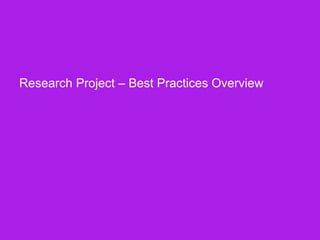





















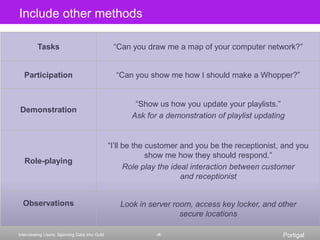















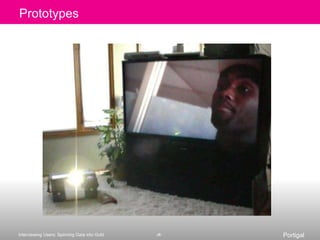














































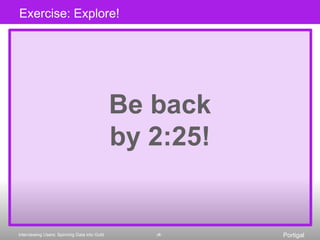

























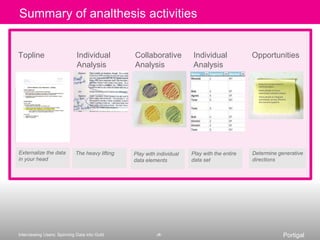
































































































































![Halstead’s_Software_Science_&_Putnam’s_Model[1].pptx](https://cdn.slidesharecdn.com/ss_thumbnails/halsteadssoftwarescienceputnamsmodel1-250502175814-4c85707e-thumbnail.jpg?width=560&fit=bounds)










